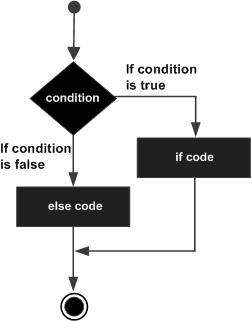An else statement can be combined with an if statement. An else statement contains the block of code that executes if the conditional expression in the if statement resolves to 0 or a false value.
The else statement is an optional statement and there could be at most only one else statement following if .

Like the else, the elif statement is optional. However, unlike else, for which there can be at most one statement, there can be an arbitrary number of elif statements following an if.
The syntax of the if...elif statement is:
The else statement is an optional statement and there could be at most only one else statement following if .
Syntax:
The syntax of the if...else statement is:if expression: statement(s) else: statement(s)
Flow Diagram:

Example:
#!/usr/bin/python var1 = 100 if var1: print "1 - Got a true expression value" print var1 else: print "1 - Got a false expression value" print var1 var2 = 0 if var2: print "2 - Got a true expression value" print var2 else: print "2 - Got a false expression value" print var2 print "Good bye!"When the above code is executed, it produces the following result:
1 - Got a true expression value 100 2 - Got a false expression value 0 Good bye!
The elif Statement
The elif statement allows you to check multiple expressions for truth value and execute a block of code as soon as one of the conditions evaluates to true.Like the else, the elif statement is optional. However, unlike else, for which there can be at most one statement, there can be an arbitrary number of elif statements following an if.
The syntax of the if...elif statement is:
if expression1: statement(s) elif expression2: statement(s) elif expression3: statement(s) else: statement(s)Core Python does not provide switch or case statements as in other languages, but we can use if..elif...statements to simulate switch case as follows:
Example:
#!/usr/bin/python var = 100 if var == 200: print "1 - Got a true expression value" print var elif var == 150: print "2 - Got a true expression value" print var elif var == 100: print "3 - Got a true expression value" print var else: print "4 - Got a false expression value" print var print "Good bye!"When the above code is executed, it produces the following result:
3 - Got a true expression value 100 Good bye!
No comments:
Post a Comment